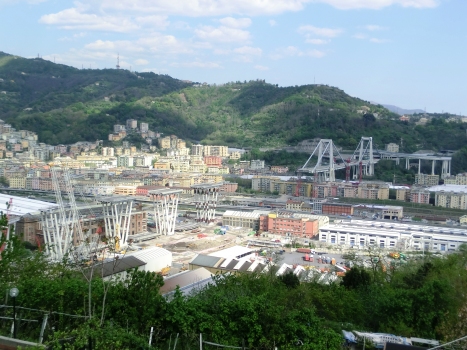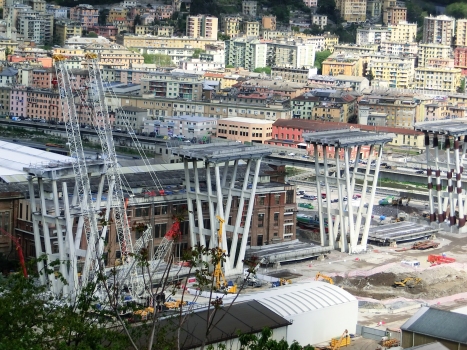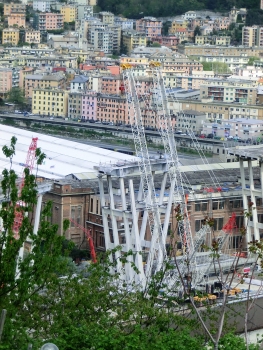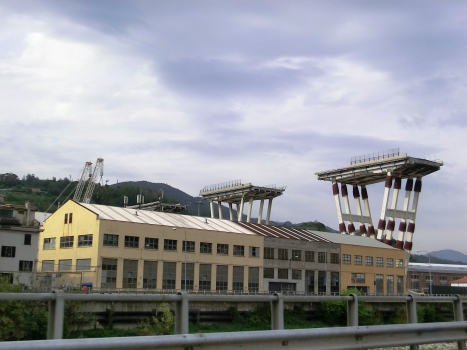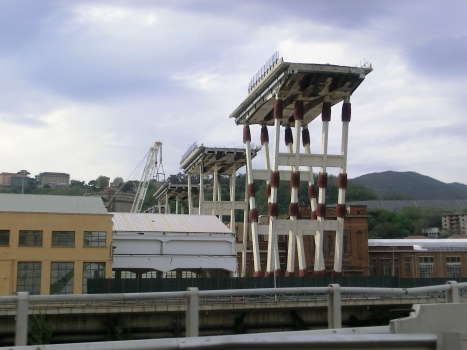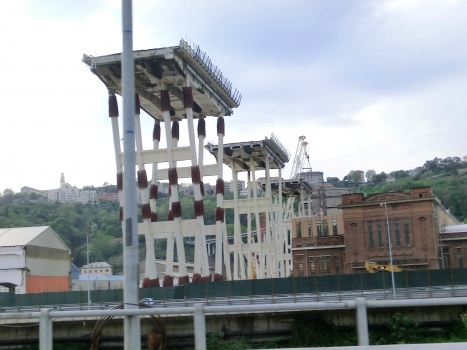General Information
| Name in local language: | Viadotto sul Polcevera, "Ponte Morandi" |
|---|---|
| Beginning of works: | 1962 |
| Completion: | 4 September 1967 |
| Status: | collapsed (14 August 2018) |
Project Type
| Structure: |
Multiple-span cable-stayed bridge |
|---|---|
| Function / usage: |
Motorway bridge / freeway bridge |
| Material: |
Prestressed concrete bridge Structurae Plus/Pro - Subscribe Now! Structurae Plus/Pro - Subscribe Now! |
Location
| Location: |
Genoa, Genova, Liguria, Italy |
|---|---|
| Address: | A10 |
| Part of: | |
| Replaced by: |
Genova San Giorgio Viaduct (2020)
|
| Coordinates: | 44° 25' 32" N 8° 53' 23" E |
Technical Information
Dimensions
| length of side spans | 6 x 73.20 m | |
| total length | 1 102 m | |
| main spans | 202.50 - 207.90 - 142.65 m | |
| deck | deck depth | 4.00 m |
| deck width | 18.00 m | |
| pylons | pylon height (total) | 100.20 m |
| pylon height (above deck) | 45.40 m |
Materials
| cables |
prestressed concrete
|
|---|---|
| deck |
prestressed concrete
|
| piers |
reinforced concrete
|
| pylons |
reinforced concrete
|
| abutments |
reinforced concrete
|
Chronology
| 14 August 2018 | The westernmost of the three pylons, the one nearest to the river, suddenly collapses in bad weather taking a significant portion of the deck as well as many cars and several trucks traveling across the bridge with it. |
|---|
Excerpt from Wikipedia
Ponte Morandi (English: Morandi Bridge), officially Viadotto Polcevera (English: Polcevera Viaduct), was a road viaduct on the A10 motorway in Genoa (Italy). It was managed by Atlantia S.p.A. (formerly Autostrade S.p.A.), a holding company operating toll motorways and airports controlled by the Benetton family.
Located on one of the major links from Italy to France and part of the European route E80, the viaduct linked the Sampierdarena and Cornigliano districts of Genoa crossing Polcevera valley. It was built between 1963 and 1967, costing ₤3.8 billion and opened on 4 September 1967. It was widely but unofficially named "Ponte Morandi" from the name of its designer, the distinguished engineer Riccardo Morandi. The official name comes from the river Polcevera that runs under the bridge.
On 14 August 2018, a partial collapse blamed on corrosion in the cable stays killed 43 people who were crossing the bridge at the time. The disaster caused a major political controversy about the poor state of infrastructure in Italy, and raised wider questions about the condition of bridges across Europe. It was later decided that the bridge would not be repaired but demolished. Demolition began in February 2019 and was completed on 28 June 2019.
History
Design
The bridge was designed by Riccardo Morandi. It was similar to his earlier 1957 design for the General Rafael Urdaneta Bridge in Venezuela, except for the stays, which in the Venezuelan bridge are not covered with prestressed concrete.
The Ponte Morandi was a cable-stayed bridge characterised by a prestressed concrete structure for the piers, pylons and deck, very few stays, as few as two per span, and a hybrid system for the stays constructed from steel cables with prestressed concrete shells poured on. The concrete was only prestressed to 10 MPa, resulting in it being prone to cracks and water intrusion, which caused corrosion of the embedded steel.
Construction
The viaduct was built between 1963 and 1967 by the Società Italiana per Condotte d'Acqua. It had a length of 1,182 metres (3,878 ft), a height of 45 metres (148 ft) at road level, and three reinforced concrete pylons reaching 90 metres (300 ft) in height; the maximum span was 210 metres (690 ft). It featured diagonal cable-stays, with the vertical trestle-like supports made up of sets of Vs: one set carrying the roadway deck, while the other pair of inverted Vs supported the top ends of two pairs of diagonal stay cables.
The viaduct was officially opened on 4 September 1967 in the presence of Italian President Giuseppe Saragat.
Maintenance and strengthening
The bridge had been subject to continual restoration work since the 1970s due to an incorrect initial assessment of the effects of creep of the concrete. This resulted in excessive deferred displacement of the vehicle deck so that it was neither level nor flat; at the worst points, it undulated in all three dimensions. Only after continual measurement, redesign and associated structural works was the vehicle deck considered acceptable, approaching horizontal by the mid-1980s.
View of Polcevera Viaduct in 2007
In a 1979 report, Morandi himself recommended: "remove all traces of rust on the exposure of the reinforcements, fill the patches with epoxy resin, and cover everything up with elastomer of very high chemical resistance". In the 1990s, the tendons on pillar 11 appeared to be most damaged. About 30% of the tendons had corroded away. The load of the bridge was 7,000 kg (15,000 lb) per tendon, while the tendons were originally capable of carrying 15,000 kg (33,000 lb). A single truck can weigh as much as 44,000 kg (97,000 lb). As of the collapse of the bridge, only pillar 11 had been internally inspected in the 1990s, showing severed and oxidized strands. From 1990 onward, the easternmost pillar 11 had its stays strengthened by flanking them with external steel cables. Pillar 10 had the stays at the top strengthened with steel sheathing in the 1990s. Following the collapse many questions have been raised about the stays. In 1979/1980, Morandi's similar bridge in Venezuela suffered one or more stay cable failures with collapse imminent.
The then-minister of infrastructures and transport Graziano Delrio, who was in charge until 1 June 2018, was informed several times during 2016 in the Italian parliament that the Morandi bridge needed maintenance.
In Genoa, in 2017, a confidential university report noted disparities in the behaviour of the stays of the now collapsed pillar 9. The minutes of a February 2018 government meeting reported that resistance and reflectometry measurements had been performed indicating an "average" reduction of the cross section of 10 to 20% of the tendons. A crack in the road had appeared at least 14 days before the collapse, near one of the southern stays of the subsequently-collapsed pillar 9. The crack may have indicated that the stay had stretched. At no point was there a suggestion to reduce the load on the bridge. Traditionally, bridges were only designed for a 50-year life span.
On 3 May 2018, the Autostrade company had announced a call for tenders for a structural upgrade of the viaduct to the value of €20,159,000, with a deadline of 11 June 2018. The work on the reinforcement of the stays on pillars 9 and 10 would have needed to be finished within five years.
Workers were installing new heavy concrete Jersey barriers on the Ponte Morandi before it collapsed, reducing the already low compressive pre-stress on the concrete of the stays and increasing the loads.
2017 modal analyses
In 2017, Carmelo Gentile and Antonello Ruccolo of the Polytechnic University of Milan studied the modal frequencies and deformations of the stays of the bridge. On pillar 9 they could identify only four global modes, and the deformations of two of these identified modes were not fully compliant. Modal frequencies were more than 10% different, specifically on the southern stays. In pre-stressed concrete beams such a difference could represent the entire effect of the non-linear pre-stresses. As little as a 2% shift could represent severe damage. The pre-stress in the Ponte Morandi has been characterised as relatively small from the start. In contrast, with bare tendons which are relatively under-constrained such as the strings in a piano, the effect of pre-stress is dominant in determining the resonant frequency. Other than pre-stress, changes in geometry, such as corrosion in the tendons could impact the resonance frequency. The effects would be reduced by the composite nature of the stays when observing global modes. Gentile had performed similar modal analyses on pillar 11 in the 1990s. Other related methods were applied on the stays of Ponte Morandi in the 1990s such as reflectometry, which was able to measure the tension but not strength of the tendons.
Replacement proposals
By the mid-2000s, the A10 route through Genoa and over the bridge had become highly congested. The city council requested proposals for improvement of traffic flow through Genoa, with the Autostrade company in 2009 proposing the "Gronda di Ponente" project to improve flow, by moving traffic to a newly built Autostrada interchange system located to the north of the city. As part of the initial study and report, the Autostrade company measured that the bridge carried 25.5 million transits a year, with traffic having quadrupled in the previous 30 years and "destined to grow, even in the absence of intervention, by a further 30% in the next 30 years". The study highlighted how the traffic volume, with daily queues at peak hours joining the Autostrada Serravalle, produced "an intense degradation of the bridge structure subjected to considerable stress", with the need for continuous maintenance. The study showed that in the option for improving what was termed as the "low gutter", it would be more economical to replace the bridge with a new one north of its current location, and then to demolish the existing bridge.[ failed verification]
In the 1990s the bridge had shown signs of weaknesses. At this point material support was added. Rust on metal materials of the bridge had become more evident since then. In 2013, fears were expressed that the structural condition of the bridge was poor. Warnings that the bridge was in danger of collapse were dismissed by the Five Star Movement as a "fairy tale" on their website. In 2016, the bridge was characterised by Antonio Brencich, a professor of Structural Engineering at the University of Genoa, as a "failure of engineering", mainly due to high maintenance costs.
Partial collapse
On 14 August 2018 at around 11:36 local time (09:36 UTC), during a torrential rainstorm, a 210-metre (690 ft) section of Ponte Morandi collapsed. This was centred on the westernmost pillar 9 which crossed the Polcevera river as well as an industrial area of Sampierdarena. Eyewitnesses reported that the bridge was hit by lightning before it collapsed. Between 30 and 35 cars and three trucks were reported to have fallen from the bridge.
A large part of the collapsed bridge and the vehicles on it fell into the rain-swollen Polcevera. Other parts landed on the tracks of the Turin–Genoa and Milan–Genoa railways, and on warehouses belonging to Ansaldo Energia, an Italian power engineering company. The latter were serendipitously largely empty because the collapse occurred on the eve of the Italian public holiday,Ferragosto.
The initial hypotheses were that a structural weakness or a landslide caused the collapse. The bridge was reportedly undergoing maintenance at the time of the collapse, including strengthening the road foundations.
It has been reported that the southern stays gave way explosively due to corrosion and damage. With only four stays, one of them giving way might have been enough for the structure to lose stability. A preliminary investigative report suggested the pillar itself may have collapsed first, but Genoa prosecutors had not provided the report's authors with a local video showing the southern stays gave way first. There is speculation that lightning may have struck the stays, or a landslide could have destabilised the base.
In July 2019, the video showing the fall of the bridge was declassified. It originated from the neraby Ferrometal company cameras and according to the officials it shows clearly that one of the steel cables at the pillar no. 9 ruptured first. After that, the road from both sides of the pillar falls and soon after also the pillar itself. However, Autostrade objects, that the video still doesn't show all bridge structures and so it doesn't really explain the cause.
According to Corriere della Sera, this was the 11th bridge collapse in Italy since 2013.
Victims and rescue efforts
Forty-three people were confirmed dead and 16 injured. The dead were 29 citizens of Italy, four from France, three from Chile, two from Albania and one each from Colombia, Jamaica, Moldova, Peru and Romania.
Multiple survivors were transported to nearby hospitals, many in critical condition. Davide Capello, the former goalkeeper for Cagliari, survived without injury and was able to walk away from his car, even though it dropped 30 metres (100 ft) before becoming wedged between parts of the fallen bridge.
The area under the remaining part of the bridge, including several homes, was evacuated. As of 02:00 the following day (midnight UTC), 12 people were known still to be missing, and voices could be heard calling from underneath the debris; rescue efforts were continuing by floodlight using techniques commonly deployed after earthquakes.
Aftermath and reactions
The railways connecting Genoa Sampierdarena (and Genoa Piazza Principe) with Genoa Borzoli and Genoa Rivarolo were closed immediately as a result of the bridge's collapse. A bus replacement service was established between the stations.
The day after the collapse, Prime Minister Giuseppe Conte declared a state of emergency for the Liguria region, which would last for a year. According to deputy minister of infrastructure Edoardo Rixi, the entire bridge would be demolished.
The Italian Football Federation announced that a minute of silence would be held for the victims of the collapse before all football events across the country during the weekend that followed the incident. On 16 August, the Lega Serie A postponed the opening 2018–19 Serie A matches for both Genoese association football clubs Genoa and Sampdoria that were originally scheduled for 19 August.
The Italian transport minister Danilo Toninelli, in office for the first time since 1 June 2018, described the incident as "an immense tragedy", but he was also known to be member of the Five Star Movement, the political party which in 2012 said that the risk of a collapse of Morandi Bridge was just a silly fairy tale 'cause "the bridge would have lasted another hundred years", quoting a 2009 evaluation by Autostrade. Governor Giovanni Toti said that the loss of the bridge was an "incident of vast proportions on a vital arterial road, not just for Genoa, but for the whole country". The disaster resulted in a drop in the stock price of the road's operator, Atlantia, by 5% the same day and by 25% two days later.
A state funeral was held on 18 August, inside the Fiera di Genova event arena, for 18 victims of the collapse, along with recognition for the firefighters and other rescue workers. Some of the victims' families refused to attend the service and instead hosted private funerals. The funeral was attended by Italian politicians such as President Sergio Mattarella, Prime Minister Giuseppe Conte, interior minister Matteo Salvini, transport minister Danilo Toninelli, and secretary of the Democratic Party Maurizio Martina.
Infrastructure
The collapse raised concerns about the general condition of infrastructure in Europe, with studies in Italy, France, and Germany suggesting that a significant number of bridges are in need of renovation or replacement due to corrosion and structural deterioration. Infrastructure investment in Italy was reduced dramatically after the 2008 financial crisis. A resident of Genoa told reporters: "The central government will scapegoat the bridge company, the company will scapegoat someone else — they're all to blame. We all know how bad our infrastructure is in Italy."
The ruling coalition put pressure on managers of the road, Autostrade per l’Italia (which is part of the Atlantia group). Deputy Prime Minister Luigi Di Maio claimed that they were "definitely to blame." Minister of the Interior Matteo Salvini also blamed supposed EU spending limits for infrastructure, but this was immediately dismissed and disproven by European Commission officials. The position of the Benetton family, whose company owns 30% of Atlantia, has also come under scrutiny. Autostrade per l’Italia's chief executive, Giovanni Castellucci, said that the bridge would be rebuilt within eight months.
Investigative committee
The investigative committee was to be chaired by Roberto Ferrazza and to have as an expert member Antonio Brencich. However, these two committee members were immediately criticised for being among the signatories of the February 2018 government report that failed to impose precautionary measures on the weakened bridge. On 23 August 2018, Brencich resigned from the inspection commission, and Minister Danilo Toninelli removed Ferrazza as the chair, for "reasons of opportunity in relation to all the institutions involved in this affair".
Symbol
A Volvo FH truck 12 380 belonging to Damonte Trasporti S.R.L. and in services for Basko Supermarket, painted in blue and green, became a widely publicised symbol of the disaster because it remained standing almost at the edge of the collapsed section. The 37-year-old driver at the time of the accident recounted to the media how he looked in shock as the bridge busy with dense traffic collapsed in front of him, as he brought his vehicle to a stop and ran back until he reached firm ground.
Demolition and replacement
The last two pillars (10 and 11) of the bridge were demolished using a tonne of explosives on 28 June 2019. The complete bridge will be removed, along with multiple damaged houses in the surroundings.
Construction of a replacement bridge, designed by Italian architect Renzo Piano, was begun on 25 June 2019 and completed the following year.
Text imported from Wikipedia article "Ponte Morandi" and modified on July 22, 2019 according to the CC-BY-SA 4.0 International license.
Participants
Relevant Web Sites
Relevant Publications
- (1997): L'art de l'ingénieur. constructeur, entrepeneur, inventeur. Éditions du Centre Georges Pompidou, Paris (France), pp. 368.
- (2001): Bridges with Multiple Cable-Stayed Spans. In: Structural Engineering International, v. 11, n. 1 (February 2001), pp. 61-82.
- (1977): Cable-Stayed Bridges. Theory and design. Crosby Lockwood Staples, London (United Kingdom), pp. 386.
- (2020): Collapse analysis of the Polcevera viaduct by the applied element method. In: Engineering Structures, v. 214 (July 2020), pp. 110659.
- (2020): The Collapse of the Morandi’s Bridge: Remarks About Fatigue and Corrosion. Presented at: IABSE Symposium: Synergy of Culture and Civil Engineering – History and Challenges, Wrocław, Poland, 7-9 October 2020, pp. 1040-1047.
- About this
data sheet - Structure-ID
20000392 - Published on:
09/09/1999 - Last updated on:
29/04/2019


